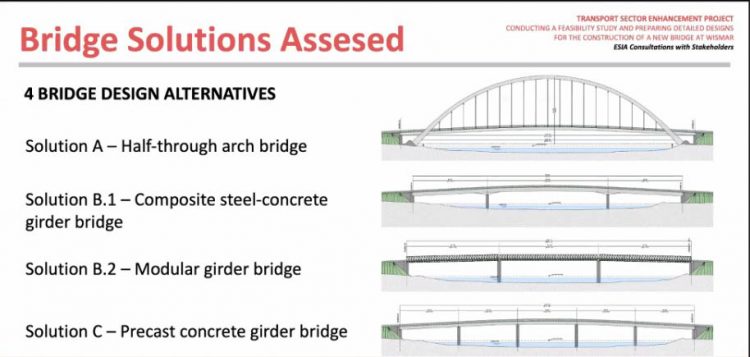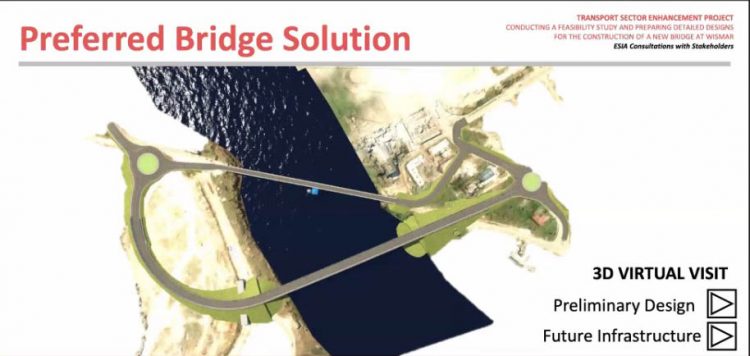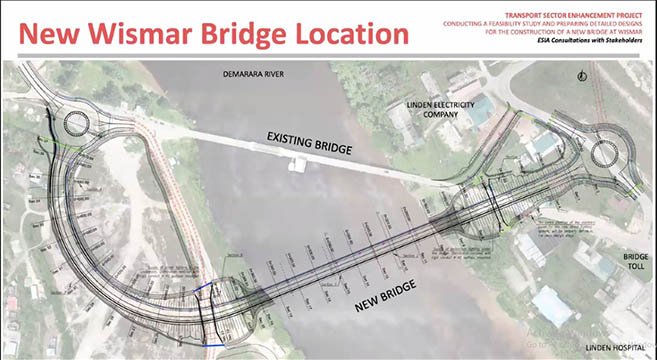An elevated precast concrete girder bridge equipped with two traffic lanes and a footpath has been proposed to replace the existing Wismar, Linden Bridge which has been deteriorating over the years.
The design of the bridge was unveiled on Tuesday night by Italy-based engineering firm – Politecnica Ingegneria ed Architettura Società Cooperativa – which was contracted by the Ministry of Public Infrastructure to conduct a feasibility study and preparation of detailed designs for the construction.
The company revealed the design during a virtual public consultation with residents and stakeholders from the mining town when they were brought up to speed with the project and given the opportunity to share their views and concerns.

Francisco Reina, Assistant Project Manager, explained that from the feasibility study they were able to generate four different designs for the new bridge. However, the best option, he said, is the precast concrete girder bridge, which is similar to the design of the existing bridge.
He stated that this bridge features a mid-range elevation with five spans at 44 meters each. The new design he explained is structurally recommended and will be constructed to accommodate all types of vehicles in Guyana.

The new location of the bridge over the Demerara River is proposed to be in proximity to the existing bridge. In the design it was also proposed that roundabouts be constructed at both ends of the bridge to accommodate an easy flow of traffic and have a multi-thoroughfare access.
Reina explained that the design for the bridge was developed after a number of criteria were considered.
“This was the preferred design…We have considered the aesthetics, technical challenges, socio economic impact, environmental impact and cost before arriving at the decision. Behind that objective there was technical analysis,” Reina responded when asked why that design was selected.
He also pointed out that before arriving at the design they carried out a traffic impact study which allowed them to design the bridge to cater for the volume of traffic extrapolated 20 years into the future.
Asked about the lifespan of the bridge and how boats would be able to traverse the river, Reina said that the bridge carries a minimum lifespan of 50 years with limited maintenance but with an effective maintenance programme in place, the bridge can last longer. He noted that the mid-range of bridge will be elevated to 11 meters.
Should the ministry go ahead with the design, Reina said construction of the bridge will take approximately 18 to 24 months upon the contract being awarded.
When asked if the flow of traffic will be disrupted during the construction of the new bridge, Reina said no. On this note he explained that they have included in the design and feasibility study, a road bypass to be constructed on the eastern end of the existing bridge.
“This will take the traffic in a different direction and we will not have any traffic congestion when the new bridge is being constructed. We have made provisions for that in the plan of the bridge,” Reina assured.
Additionally, the firm said they will soon carry out further environmental impact assessments on the marine and terrestrial life.
“The impacts on the environment study is not fully completed. Our consultations will have [to] continue and by this week we should be back on the ground. We would have been there earlier but our team had limitations due to COVID-19,” Environmen-tal Consultant Marciano Glasgow said in response to a question by Esther Haynes.
He underscored that the environment must be considered and safeguarded in every developmental project and Politecnica will not ignore that.
Meanwhile, several participants questioned the fate of the existing bridge when construction of the new bridge comes into play, while other put forward suggestions on what should be done with the old structure.
Suggestions for the bridge be kept and used as a tourist site, to be discarded, and even to be used by pedestrians and cyclists, were put forward.
Several persons posited that if the bridge is kept, money that could be invested in other developments will be used up on maintenance of the bridge.
Chief Transport Planning Officer, Patrick Thompson, in responding to the concerns said that while there has been much deliberation involving stakeholders, no decision has been made on what will become of the old bridge.
He admitted that they have been considering turning it into a pedestrian and cyclist-only bridge.
Earlier this year, bids were opened at the National Procurement and Tender Administration Board for a feasibility study and preparation of detailed designs for the construction of a new bridge at Wismar, Linden.
Politecnica Ingegneria ed Architettura Società Cooperativa in association with Marcel Gaskin and Associates had tendered a US$700,000 bid for the project.









